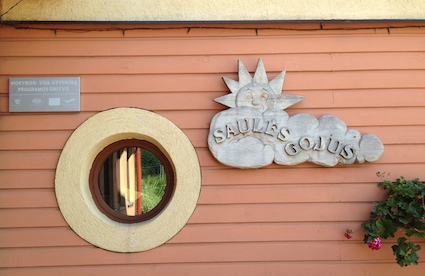
Saules Gojus is a remarkable school based just outside Vilnius, the capital city of Lithuania. Established in 2004 by Laima Sirutiene, it is a vision of education which recognises the value of humanity and learning from each other. German and English are spoken in addition to Lithuanian. International partnerships are actively sought, developed and celebrated.
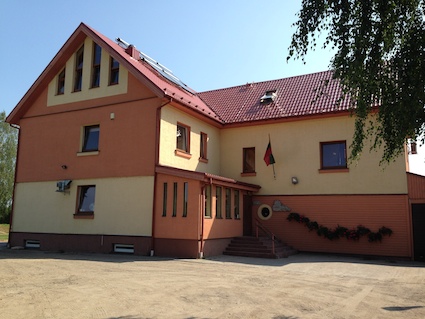
One of the founder’s, Andreas Rodenbeck has been proactive in developing the school’s approach to sustainability. The recent building extension to the old school house is a straw bale construction. Careful attention to natural lighting and creating a feeling of calm spaciousness was evident. I liked the straw feature in this toilet which serves to remind users of the nature of the building.
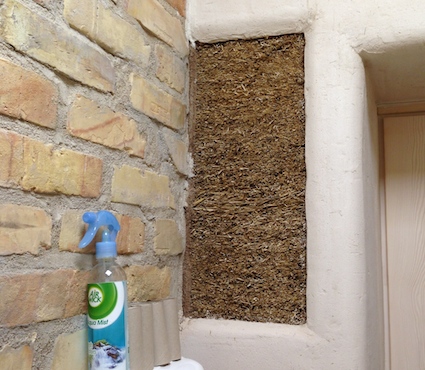
Their curriculum is grounded in real world experiences. Every year begins with a two-week immersion in the nearby forest. The classes set up their forest space with stumps for sitting, a campfire and toileting system. Some of the new youngest children may need to have their afternoon nap in the house, but otherwise, the whole day is outside. The use of tools and practical work is actively encouraged.
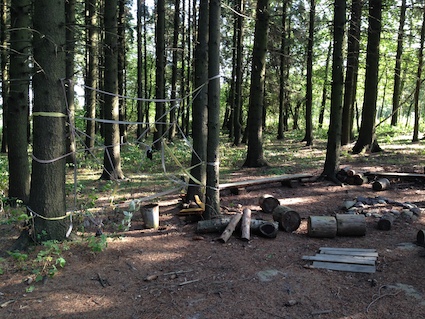
The outdoor area is spacious. On the day I visited there was building work in progress so I don’t feel I’m showing the place at its working best. Also it was the summer holidays – the numbers of children present were a lot less – just some of the kindergarten children. Naturally any school is in a state of flux and rest during the summer.
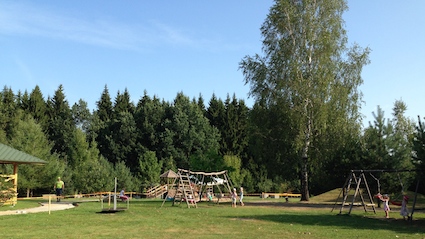
At the bottom of the garden, creating a nice link with the forest, is a planted orchard. These trees have been planted over the years by the children as part of a positive legacy. By this I mean that children should have the opportunity to leave a positive reminder of their time at school.
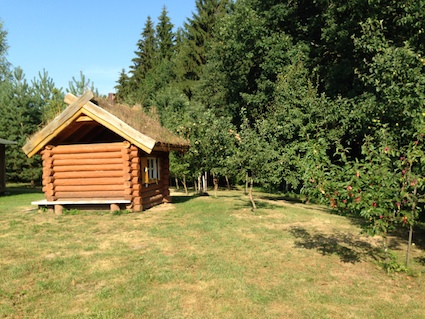
The legacy is also an act of environmental stewardship and a reminder of our need to care for the land. In the photo below, Laima is standing under an oak tree planted by Zoe, the daughter of a mutual friend 8 years ago.
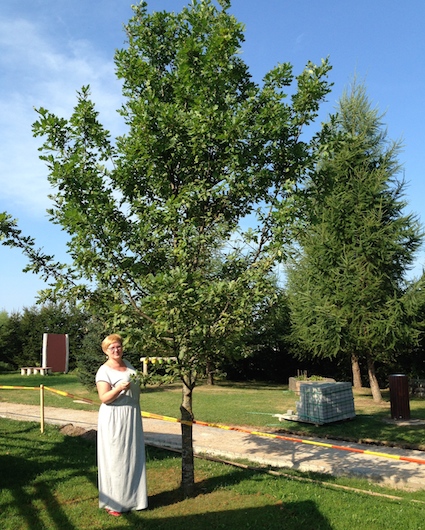
In the corner of the garden near the forest is the compost heap. Now this may sound strange but I was delighted to see such a creative approach. Forget a traditional bin. The material placed here is used as an informal bed to grow melons. Sadly this year, there’s not been enough rain for a good melon harvest.

Gardening is part of the curriculum and every year all children are involved in growing projects. The raised beds below are typical of many schools.

However I liked that in other beds in front of the house, the plants had all been clearly labelled.
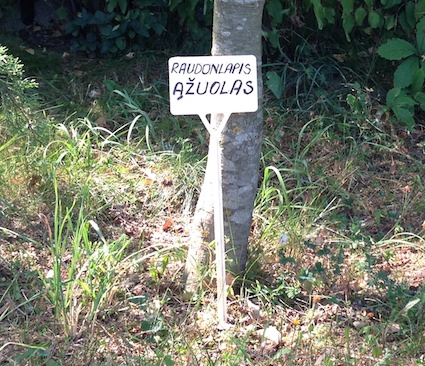
There is a fire pit in the outdoor space as well as several in the forest. What interested me is that the use of stone and the spaciousness feel of the feature! It creates a wide boundary which doubled up as seating space but which made the fire pit accessible.
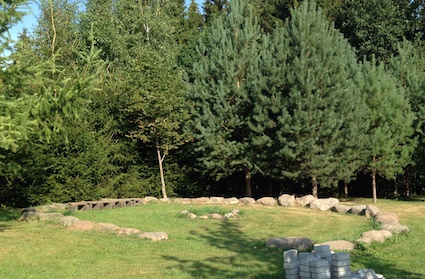
Through observing how children behave outside and what engages them, it is possible to develop features which meet their learning needs. It is also interesting that these needs seem to cross cultural boundaries. Near the centre of the outdoor space is an artificial hill.
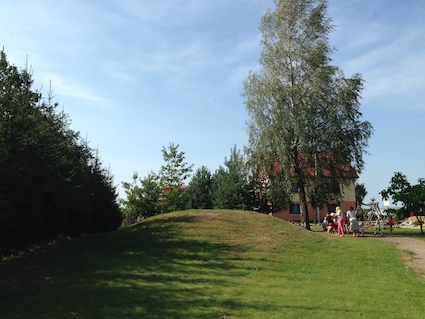
This was created because children loved to roll down it in the summer, sledge down it in winter and experience the joy of taking a deep breath and running down the slope too. Height matters to children and indoors, this was recognised as many of the teaching rooms had loft dens – and over the years these had increased in size too. The most recent taking up a good portion of the room.
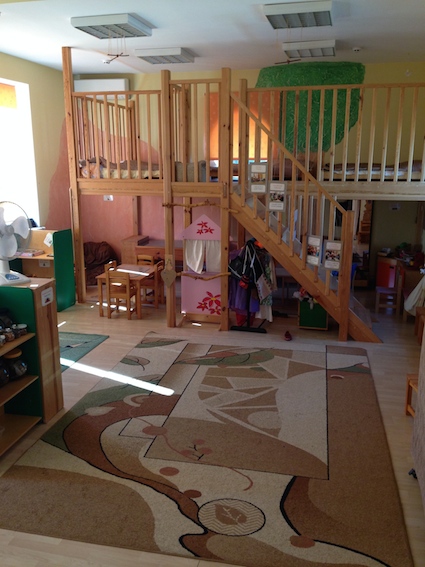
Every outdoor space needs a sand pit. Ideally, the bigger the better. This is another feature that meets children’s desires to discover, create, explore and invent. The parasols are an economic solution to providing shade in the summer months.
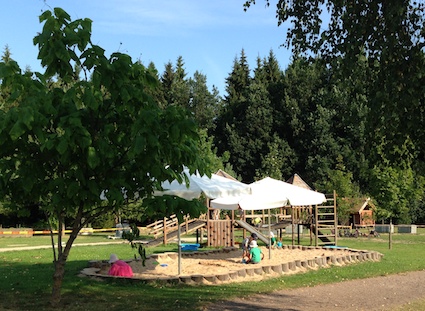
Indications of the outdoor ethos is evident inside too. The cloakroom areas are designed to cope with wet weather, mud and the realities of children traipsing in and out of the school.
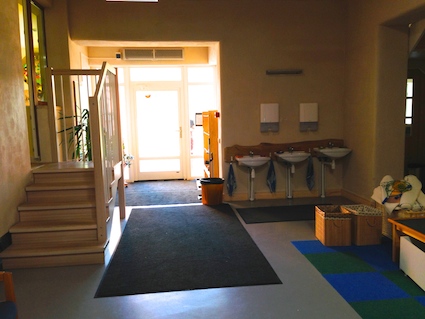
Each child has a 4-peg upright cubby for storing wellies, outdoor gear, accessories and spare clothes. There is one upright drier which easily suffices for the 100 children who attend the school. Big mats, handwashing facilities and lots of space add to this well-thought out area.
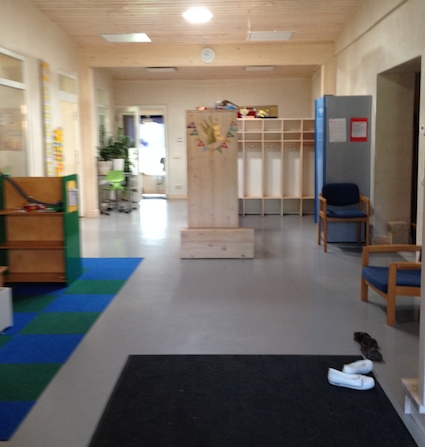
The calm feel of the indoor rooms were apparent. Lots of wood and natural materials are present. Little touches like the corner below with the cork tiles, wooden numbers and registration tree all send the message that the real world beyond the walls is valued too.

In order to avoid lots of holes in the walls, displays are attached either to the cork or to these trees. It is simply fine rods of wood nailed to the walls. As you can imagine, this lends itself nicely to seasonal work being displayed.
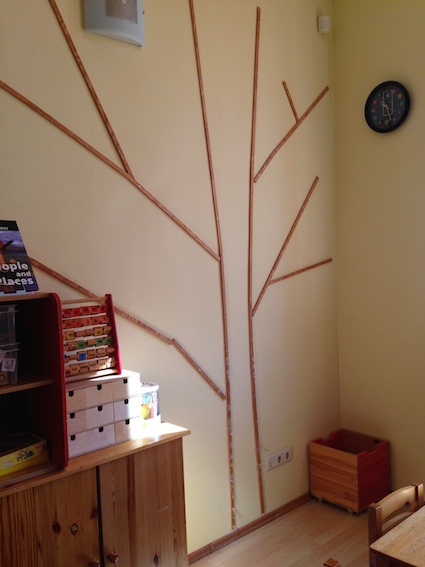
Finally there is a strong emphasis on the arts and creativity. The art teacher ensures that unwanted items and natural materials are used with bought resources kept to a bare minimum.
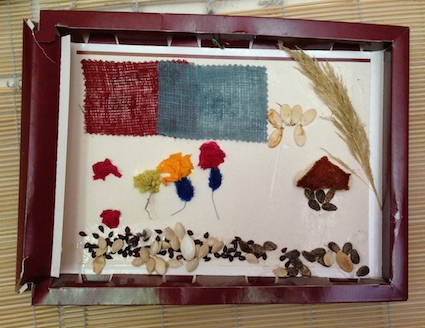
Saulas Gojus being fee-paying is unusual in Lithuania where almost all provision is state run. However, it would seem from my stay in Lithuania that it is those people who are setting up independent schools which are breaking the mould and encouraging positive changes within education system as a whole.




















From your photos this feels ‘Scandinavian’ especially the large hallway. Hope you’ll add this go the new Outdoor Play Party on Friday.
Hi Kierna. You are correct to some extent. The main influence is German but the school is very international with lots of partnerships.
Thank you for this trip down memory lane. When we lived in Vilnius my daughter Zoe attended Saules Goyus a couple of days a week and I spend some time teaching English there too. I love what they do and the beauty they create and connect with nature. A truly creative, resilient and loving family place to be. I will be back!
Thanks Julia for linking me up! The school even though many children were on holiday, oozed with calm happiness. It’s a remarkable achievement by Laima and her family.
What a lovely school and a great way to showcase how outdoor education can work. I really like the trees on the wall inside the classroom as well
#outdoorplayparty
Agreed!
This school looks amazing. I would love Little Man to attend somewhere like this. Not too much hope of that round here though. Thanks for sharing 🙂
This is my ideal school!!!! I teach in a small public primary school in the Italian Alps. It is a certified Eco School. My idea of school is fully in line with your philosophy. I’m trying to contaminate other teachers living in my area and your posts are a source of inspiration. Thank you for shearing.
You are welcome – there are many schools around the world which share your philosophy! Don’t give up and do reach out!